Brihat Jataka by Varahamihira [Sanskrit/English]
by Michael D Neely | 2017 | 105,064 words
The Sanskrit text and English translation of the Brihat Jataka of Varahamihira.
Verse 26.14
वेलाम् अथ विलग्नं च होराम् अंशकम् एव च ।
पञ्चकेषु विजानीयान् नष्ट जातक सिद्धये ॥ १४॥
velām atha vilagnaṃ ca horām aṃśakam eva ca |
pañcakeṣu vijānīyān naṣṭa jātaka siddhaye || 14||
Then among those consisting of five one should know the time, lagna, hora, and indeed the navamsha for the reconstruction of a lost horoscope.
English translation by Michael D Neely (2007)
Word-for-Word grammar analysis breakdown
velām (stem form: velā) (feminine, accusative, singular) = the time
atha (conjunction) (indeclinable) = then
vilagnam (vi + 1st class verb root: lag) (past passive participle, neuter, nominative, singular) = the lagna
ca (conjunction) (indeclinable) = and
horām (stem form: horā) (feminine, accusative, singular) = hora
aṃśakam (stem form: aṃśaka) (masculine, accusative, singular) = navamsha
eva (interjection) (indeclinable) = indeed ca (conjunction) (indeclinable) = and
pañcakeṣu (stem form: pañcaka) (masculine, locative, plural) = among those consisting of five
vijānīyāt (vi + 9th class verb root: jñā) (optative, parasmaipada, 3rd person, singular) = one should know
naṣṭa = lost
jātaka = horoscope
siddhi = reconstruction
naṣṭajātakasiddhaye (stem form: naṣṭajātakasiddhi) (feminine, dative, singular) = for the reconstruction of a lost horoscope
Glossary of Sanskrit terms
Note: This extracts Sanskrit terms and links to English definitions from the glossary, based on an experimental segmentation of verse (26.14). Some terms could be superfluous while some might not be mentioned. Click on the word to show English definitions.
Vela, Atha, Vilagna, Hora, Amshaka, Eva, Pancaka, Vijani, Vija, Iyat, Nashta, Jataka, Siddhi,
Other editions:
Also see the following editions of the Sanskrit text or (alternative) English translations of the Verse 26.14

Brihat Jātaka of Varāhamihira
by Michael D Neely (2007)
Edition includes original Sanskrit text, English translation and word-for-word analysis.